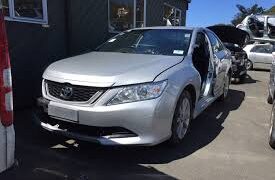Winter is approaching, and you know what that means – snowflakes dancing in the air, cozy nights by the fireplace, and endless mugs of hot cocoa. But amidst all this picturesque charm lies a challenge: protecting your car from those frigid winter conditions! As temperatures drop and icy roads become an everyday reality, it’s time to gear up for a new season of driving obstacles. Don’t let Jack Frost catch you off guard – join us as we dive into the essential tips and tricks for winterizing your car, ensuring both safety and peace of mind throughout the chilly months ahead. Buckle up because it’s time to prepare your trusty steed for cold weather conditions like never before.
Introduction to Preparing Your Car for the Winter
As winter approaches, you’ll want to take some steps to prepare your car for the colder weather. This is especially important if you live in an area that experiences freezing temperatures and snowfall.
One of the most important things you can do is make sure your car’s antifreeze levels are topped off. Antifreeze helps keep your engine from freezing up, so it’s essential in cold weather conditions. You should also have your battery checked to make sure it’s in good working order. Cold weather can be tough on batteries, so it’s a good idea to get it checked before the winter season hits.
In addition, you’ll want to change your oil and switch to a winter-weight oil. This type of oil is designed for cold weather conditions and will help keep your engine running smoothly. You should also check your tires and make sure they have enough tread. Winter driving can be treacherous, so it’s important to have good tires to help keep you safe on the road.
Don’t forget to pack a winter emergency kit for your car. This should include items like a blanket, extra clothes, food, water, and a first-aid kit. If you’re prepared for the worst, you’ll be able to handle anything the winter throws your way.
Benefits of Winterizing Your Car
When temperatures start to drop, it’s important to take steps to winterize your car. This will help ensure that your vehicle is able to withstand the colder weather conditions and perform at its best. Winterizing your car can also help you avoid costly repairs down the road.
Some of the main benefits of winterizing your car include:
1. Improving fuel efficiency: When you properly maintain your car and keep it clean, you can actually improve your fuel efficiency by up to 3%. This means that you’ll save money on gas over the course of the winter.
2. avoiding breakdowns: No one wants their car to break down in the middle of a cold winter night. By taking care of your car and making sure it’s in good working order, you can help avoid costly repairs or even a dangerous breakdown.
3. extending the life of your vehicle: Regular maintenance and care will extend the overall life of your vehicle. This means that you’ll get more miles out of your car before needing to replace it.
4. improving safety: Winter weather can be treacherous, but properly preparing your car can help keep you safe on the roadways. From ensuring good visibility with clean windshields to making sure your tires have adequate tread, taking care of your car will help keep you safe all winter long.
How to Inspect the Cooling System
The cooling system is one of the most important parts of your car to maintain and winterize. Coolant levels should be checked regularly, and the system should be flushed and refilled every two years. The radiator cap should also be inspected for cracks or leaks.
To inspect the cooling system, start by checking the coolant level. The coolant should be at least at the minimum fill line, and preferably closer to the maximum line. If it is low, add more coolant until it reaches the proper level. Next, check the radiator hoses for any cracks or leaks. If any are found, they should be replaced as soon as possible.
Inspect the radiator cap for cracks or leaks. If any are found, replace the cap with a new one.
How to Check and Change Your Oil
It is important to check your oil level regularly and before long trips. Checking your oil is easy to do and only takes a few minutes. You will need a clean rag or paper towel and the dipstick from your car.
Locate the dipstick. On most cars, it is located near the front of the engine on the passenger side. Insert the dipstick fully into the oil fill hole. Be careful not to touch anything hot. Remove the dipstick and look at the end. The oil should reach at least the minimum line, but it’s best if it reaches the maximum line. If it doesn’t, add a bit of oil until it does. Wipe off any excess oil with a clean rag or paper towel then replace the dipstick making sure it’s fully seated in its rightful place.
Checking Tires and Other Components
As the winter season approaches, it’s important to make sure your car is prepared for the cold weather conditions. One of the most important things you can do is to check your tires and other components to ensure they’re in good condition.
Tires are one of the most important components of your car, and they need to be in good condition to provide adequate traction on snowy and icy roads. If your tires are worn or damaged, they may not be able to grip the road as well, which could lead to an accident. It’s a good idea to inspect your tires before the winter season begins and replace them if necessary.
In addition to checking your tires, you should also inspect other key components of your car such as the battery, brakes, and wipers. These components are all essential for safe driving in winter conditions. Make sure they’re in good working order before you head out on the road.
By taking the time to check your tires and other components, you can help ensure a safe and enjoyable winter driving experience.
Important Tips on Replacing Fluids
As the seasons change and temperatures drop, it’s important to remember to change your car’s fluids. This is especially important if you live in an area that experiences freezing temperatures. Here are some tips on replacing fluids in your car:
1. Antifreeze – also known as coolant, helps to keep your engine from freezing in cold weather. Be sure to check your car’s owner’s manual to see what type of antifreeze/coolant is required for your vehicle. You should also flush and replace your coolant every few years, as it can break down over time.
2. Oil – You should check your oil level regularly, and change it according to the schedule recommended in your car’s owner’s manual. In general, most cars need an oil change every 5,000 miles or so. In colder weather, it’s a good idea to switch to a thicker weight oil, which will help protect your engine from the extreme cold temperatures.
3. Windshield Washer Fluid – This is another fluid that you should check regularly and top off as needed. In winter weather, it’s a good idea to use a windshield washer fluid that has antifreeze in it, as this will help prevent the fluid from freezing on your windshield while you’re driving.
Following these tips will help ensure that your car is properly prepared for the winter season, and that your engine is running smoothly.
Maintaining Visibility with Wipers & Lights
In the winter months, it’s important to maintain visibility while driving. Be sure to keep your windshield wipers in good working condition and clear of any ice or snow. Also, make sure your headlights are clean and clear of any debris.
Conclusion
Winterizing your vehicle should be a part of basic car maintenance and can help you avoid inconveniences and potential hazards. In order to keep your car running smoothly during the colder months, it is important to ensure that all winter preparation is completed. Taking the time now to check fluid levels, inspect wiper blades, test heater fan speed and adjust tire pressure will save you from dealing with a breakdown in cold weather conditions. With these tips, winterizing your car can be an easy process that ensures safe driving throughout the season.



































